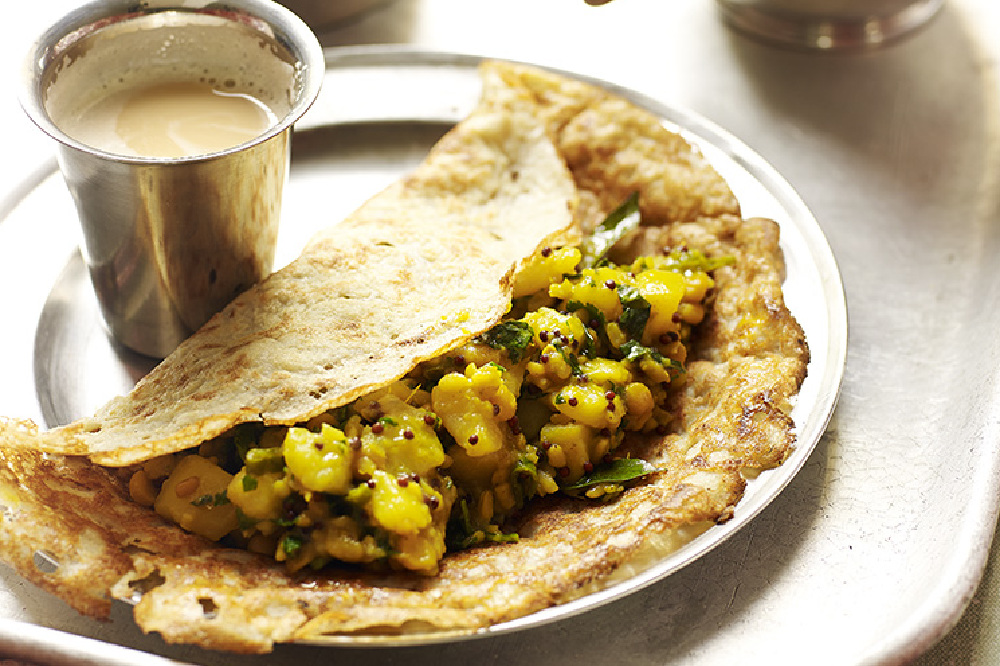Difficulty rating: **

Vegan masala dosa
Special equipment: Blender, heavy, non-stick frying pan
Serves: 4
Prep time: 15 minutes, plus 2–3 hours soaking and 12 hours fermenting
Cooking time: 6–8 minutes to cook each dosa, plus 15 minutes for the filling
Masala dosa is a breakfast (or brunch) dish served throughout India but specifically in the south, where it is eaten in roadside vegetarian ‘hotels’ and cafés. It is usually served with a spicy and sweet gravy and cooling coconut chutney – masala means ‘spice mixture’ in India. Suitable for vegans, this is a relatively simple dish to recreate, although you have to ferment the batter for 12–24 hours so you get that wonderful sour flavour and fluffy texture. The batter will keep in the fridge for up to a week. The reward that you will get from making this yourself is the wonderfully crispy lace-like batter that simply isn’t possible with a takeaway.
For the dosa batter:
300g/11oz/11/2 cups basmati rice
50g/2oz/1/4 cup urad dhal
50g/2oz/1/4 cup chana dhal
15ml/1 tbsp fenugreek seeds
pinch of salt
oil, for frying
For the filling:
500g/11/4lb waxy potatoes, chopped into 1cm/1/2in cubes
30ml/2 tbsp oil
2 red onions, finely chopped
15ml/1 tbsp black mustard seeds
30ml/2 tbsp urad dhal
30ml/2 tbsp chana dhal
2 dried chillies
3 fresh green chillies
handful of fresh curry leaves
5cm/2in-piece of fresh root ginger, peeled and grated
lemon juice, to taste
2.5ml/½ tsp ground turmericsalt and ground black pepper
- The day before you want to eat the masala dosa, make the dosa batter by rinsing the rice in cold water until the water runs clear. Soak in a large bowl of fresh cold water for about 2–3 hours.
- Rinse the lentils and fenugreek seeds and soak them in more cold water in a separate bowl for the same duration.
- Drain the rice and lentils, reserving a little of the water. Liquidise the rice and lentils in a blender, adding some of the reserved soaking water if necessary, until you achieve a mixture with a grainy pouring consistency.
- Cover and place in a large bowl in a warm draught-free area for about 12 hours or overnight to ferment and double in size. Warm weather will speed this up.
- Once the batter is fermented and bubbly, heat a heavy non-stick frying pan over a medium heat and pour in 2.5ml/½ tsp oil. Put a couple of ladles of batter into the pan and sprinkle over a little salt, then swirl the batter around the pan. Cook for 3–4 minutes on each side, until crispy and golden. Set aside to keep warm and repeat the process to make as many pancakes as you like. Any surplus mixture can be kept, covered, in the fridge for up to a week.
- To make the filling, boil the potatoes in salted water for 8–10 minutes or until tender. Drain and break up slightly with a fork.
- Meanwhile, put the oil into a large frying pan and place over a medium heat. Add the onions and cook for 10 minutes, until softened.
- Add the mustards seeds and lentils and cook for 3–4 minutes. Stir in the dried and fresh chillies, curry leaves, ginger, lemon juice, turmeric, and salt and pepper to taste.
- Combine the onion mixture with the broken-up potatoes and check the seasoning again, adjusting as necessary.
- Fill the warmed pancakes with the potato mixture, folding them over.
Cook’s Tips
• A waxy potato is more practical for the filling as it will withstand the cooking without falling apart.
• You may have to source the dhals and fenugreek seeds in an Indian supermarket or online.
Recipe from Haynes Publishing’s Fakeaway Manual, £22.99 and available from www.haynes.com

